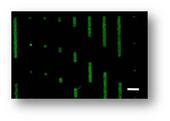Highlight
Utilizing micropatterning and microfluidics technology to elucidate receptor-ligand binding kinetic parameters
Achievement/Results
Tommy Tong states that if cancer cells spread through the body, they can be very lethal to human health. The initial steps of the cancer cell migration mechanism involve the capture and the rolling of cells on sticky molecules on blood vessel surfaces. At the molecular level, this adhesive interaction between the sticky molecules (receptors and ligands) is characterized by kinetic constants for association (Kon) and dissociation (Koff).
We have designed a method to measure these kinetic binding constants. In particular, we have fabricated a three-sided, open-channel micro-device made from soft, elastic material as a model of our blood vessel. A glass slide is micro-patterned with different lengths of “sticky” protein molecules (selectins) and the micro-device is then sealed on top of the slide. A syringe pump is used to flow a solution containing cancer cells through the device. Utilizing such an assay, we are able to study how the binding kinetic constants are influenced by fluid velocity and adhesion molecule density.
Address Goals
IGERT fellow Tommy Tong’s research uses micropatterning and microfluidics tools to study cell interactions with patches of ligands presented from patterned surfaces. In these well controlled experiments, Tommy uses concepts central to chemical engneering reactor design in a new context. In reactor design, engineers study molecular reactions in terms of molecular residence time in a reactor, and can infer reaction kinetics using well defined thoeretical approaches. Here the concept of residence time of the cell over a ptach of surface presenting adhesive molecules is exploited to infer binding kinetics. This expansion of a fundamental concept from one field into another is central to the IGERT success.






